 With the imposition of a new lockdown in England from 5 November to 2 December and in Wales from 3 October to 9 November, and with strong restrictions in Scotland and Northern Ireland, the UK economy is set to return to negative growth – a W-shaped GDP growth curve.
With the imposition of a new lockdown in England from 5 November to 2 December and in Wales from 3 October to 9 November, and with strong restrictions in Scotland and Northern Ireland, the UK economy is set to return to negative growth – a W-shaped GDP growth curve.
With the closure of leisure facilities and non-essential shops in England and Wales, spending is likely to fall. Without support, many businesses would fail and potential output would fall. In terms of aggregate demand and supply, both would decline, as the diagram below illustrates. (Click here for a PowerPoint.)
The aggregate demand curve shifts from AD1 to AD2 as consumption and investment fall. Exports also fall as demand is hit by the pandemic in other countries. 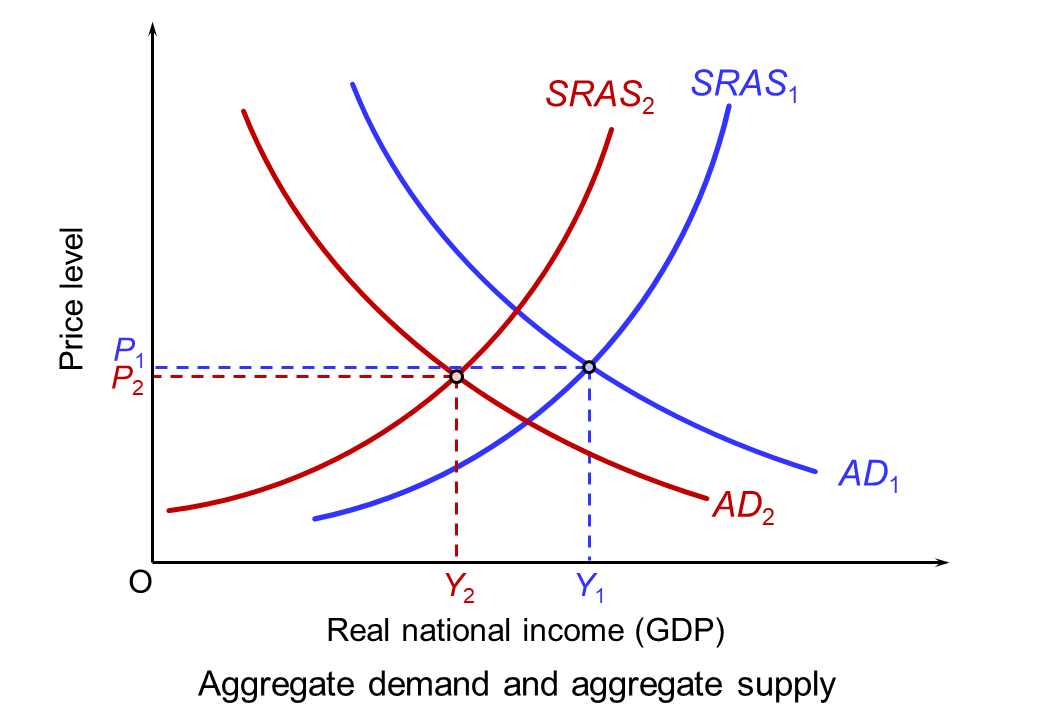 The fall in aggregate supply is represented partly by a movement along the short-run aggregate supply curve (SRAS) as demand falls for businesses which remain open (such as transport services). Largely it is represented by a leftward shift in the curve from SRAS1 to SRAS2 as businesses such as non-essential shops and those in the hospitality and leisure sector are forced to close. What happens to the long-run supply curve depends on the extent to which businesses reopen when the lockdown and any other subsequent restrictions preventing their reopening are over. It also depends on the extent to which other firms spring up or existing firms grow to replace the business of those that have closed. The continuing rise in online retailing is an example.
The fall in aggregate supply is represented partly by a movement along the short-run aggregate supply curve (SRAS) as demand falls for businesses which remain open (such as transport services). Largely it is represented by a leftward shift in the curve from SRAS1 to SRAS2 as businesses such as non-essential shops and those in the hospitality and leisure sector are forced to close. What happens to the long-run supply curve depends on the extent to which businesses reopen when the lockdown and any other subsequent restrictions preventing their reopening are over. It also depends on the extent to which other firms spring up or existing firms grow to replace the business of those that have closed. The continuing rise in online retailing is an example.
With the prospect of falling GDP and rising unemployment, the UK government and the Bank of England have responded by giving a fiscal and monetary boost. We examine each in turn.
Fiscal policy
 In March, the Chancellor introduced the furlough scheme, whereby employees temporarily laid off would receive 80% of their wages through a government grant to their employers. This scheme was due to end on 31 October, to be replaced by the less generous Job Support Scheme (see the blog, The new UK Job Support Scheme: how much will it slow the rise in unemployment?). However, the Chancellor first announced that the original furlough scheme would be extended until 2 December for England and then, on 5 November, to the end of March 2021 for the whole of the UK. He also announced that the self-employed income support grant would increase from 55% to 80% of average profits up to £7500.
In March, the Chancellor introduced the furlough scheme, whereby employees temporarily laid off would receive 80% of their wages through a government grant to their employers. This scheme was due to end on 31 October, to be replaced by the less generous Job Support Scheme (see the blog, The new UK Job Support Scheme: how much will it slow the rise in unemployment?). However, the Chancellor first announced that the original furlough scheme would be extended until 2 December for England and then, on 5 November, to the end of March 2021 for the whole of the UK. He also announced that the self-employed income support grant would increase from 55% to 80% of average profits up to £7500.
In addition, the government announced cash grants of up to £3000 per month for businesses which are closed (worth more than £1 billion per month), extra money to local authorities to support businesses and an extension of existing loan schemes for business. Furthermore, the government is extending the scheme whereby people can claim a repayment ‘holiday’ for up to 6 months for mortgages, personal loans and car finance.
The government hopes that the boost to aggregate demand will help to slow, or even reverse, the predicted decline in GDP. What is more, by people being put on furlough rather than being laid off, it hopes to slow the rise in unemployment.
Monetary policy
At the meeting of the Bank of England’s Monetary Policy Committee on 4 November, further expansionary monetary policy was announced. Rather than lowering Bank Rate from its current historically low rate of 0.1%, perhaps to a negative figure, it was decided to engage in further quantitative easing.
 An additional £150 billion of government bonds will be purchased under the asset purchase facility (APF). This will bring the total vale of bonds purchased since the start of the pandemic to £450 billion (including £20 billion of corporate bonds) and to £895 billion since 2009 when QE was first introduced in response to the recession following the financial crisis of 2007–8.
An additional £150 billion of government bonds will be purchased under the asset purchase facility (APF). This will bring the total vale of bonds purchased since the start of the pandemic to £450 billion (including £20 billion of corporate bonds) and to £895 billion since 2009 when QE was first introduced in response to the recession following the financial crisis of 2007–8.
The existing programme of asset purchases should be complete by the end of December this year. The Bank of England expects the additional £150 billion of purchases to begin in January 2021 and be completed within a year.
UK quantitative easing since the first round in March 2009 is shown in the chart above. The reserve liabilities represent the newly created money for the purchase of assets under the APF programme. (There are approximately £30 billion of other reserve liabilities outside the APF programme.) The grey area shows projected reserve liabilities to the end of the newly announced programme of purchases, by which time, as stated above, the total will be £895 billion. This, of course, assumes that the Bank does not announce any further QE, which it could well do if the recovery falters.
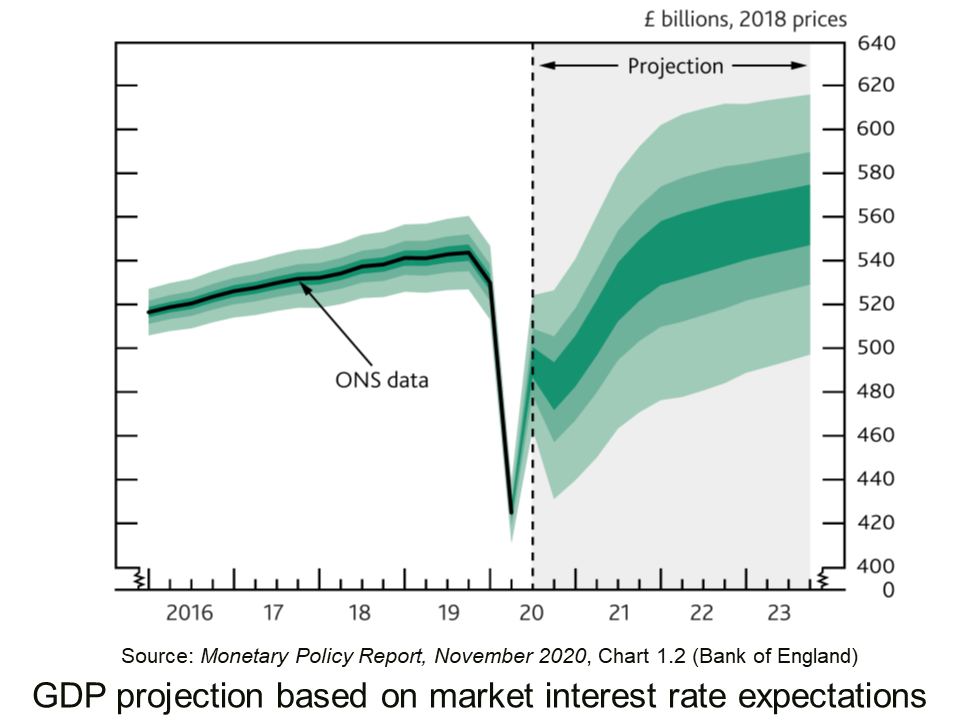
Justifying the decision, the MPC meeting’s minutes state that:
There are signs that consumer spending has softened across a range of high-frequency indicators, while investment intentions have remained weak. …The fall in activity over 2020 has reflected a decline in both demand and supply. Overall, there is judged to be a material amount of spare capacity in the economy.
Conclusions
How effective these fiscal and monetary policy measures will be in mitigating the effects of the Covid restrictions remains to be seen. A lot will depend on how successful the lockdown and other restrictions are in slowing the virus, how quickly a vaccine is developed and deployed, whether a Brexit deal is secured, and the confidence of both consumers, businesses and financial markets that the economy will bounce back in 2021. As the MPC’s minutes state:
The outlook for the economy remains unusually uncertain. It depends on the evolution of the pandemic and measures taken to protect public health, as well as the nature of, and transition to, the new trading arrangements between the European Union and the United Kingdom. It also depends on the responses of households, businesses and financial markets to these developments.
Articles
- Covid: Rishi Sunak to extend furlough scheme to end of March
BBC News (6/11/20)
- Furlough extended until March and self-employed support boosted again
MSE News, Callum Mason (6/11/20)
- Number on furlough in UK may double during England lockdown
The Guardian, Richard Partington (3/11/20)
- ‘We wouldn’t manage without it’: business owners on the furlough extension
The Guardian, Molly Blackall and Mattha Busby (6/11/20)
- Sunak’s abrupt turn on UK furlough scheme draws criticism from sceptics
Financial Times, Delphine Strauss (6/11/20)
 Coronavirus: Bank of England unleashes further £150bn of support for economy
Coronavirus: Bank of England unleashes further £150bn of support for economySky News, James Sillars (5/11/20)
- Bank of England boss pledges to do ‘everything we can’
BBC News, Szu Ping Chan (6/11/20)
- Savers are spared negative rates but the magic money tree delivers £150bn more QE: What the Bank of England’s charts tell us about the economy
This is Money, Simon Lambert (5/11/20)
- Covid-19 and the victory of quantitative easing
The Spectator, Bruce Anderson (26/10/20)
- Will the Bank of England’s reliance on quantitative easing work for the UK economy?
The Conversation, Ghulam Sorwar (9/11/20)
- With a W-shaped recession looming and debt piling up, the government should start issuing GDP-linked bonds
LSE British Politics and Policy blogs, Costas Milas (6/11/20)
Official documents
Questions
- Illustrate the effects of expansionary fiscal and monetary policy on (a) a short-run aggregate supply and demand diagram; (b) a long-run aggregate supply and demand diagram.
- In the context of the fiscal and monetary policy measures examined in this blog, what will determine the amount that the curves shift?
- Illustrate on a Keynesian 45° line diagram the effects of (a) the lockdown and (b) the fiscal and monetary policy measures adopted by the government and Bank of England.
- If people move from full-time to part-time working, how is this reflected in the unemployment statistics? What is this type of unemployment called?
- How does quantitative easing through asset purchases work through the economy to affect output and employment? In other words, what is the transmission mechanism of the policy?
- What determines the effectiveness of quantitative easing?
- Under what circumstances will increasing the money supply affect (a) real output and (b) prices alone?
- Why might quantitative easing benefit the rich more than the poor?
- How could the government use quantitative easing to finance its budget deficit?
 We’ve considered Keynesian economics and policy in several blogs. For example, a year ago in the post, What would Keynes say?, we looked at two articles arguing for Keynesian expansionary polices. More recently, in the blogs, End of the era of liquidity traps? and A risky dose of Keynesianism at the heart of Trumponomics, we looked at whether Donald Trump’s proposed policies are more Keynesian than his predecessor’s and at the opportunities and risks of such policies.
We’ve considered Keynesian economics and policy in several blogs. For example, a year ago in the post, What would Keynes say?, we looked at two articles arguing for Keynesian expansionary polices. More recently, in the blogs, End of the era of liquidity traps? and A risky dose of Keynesianism at the heart of Trumponomics, we looked at whether Donald Trump’s proposed policies are more Keynesian than his predecessor’s and at the opportunities and risks of such policies.
The article below, Larry Elliott updates the story by asking what Keynes would recommend today if he were alive. It also links to two other articles which add to the story.
Elliott asks his imaginary Keynes, for his analysis of the financial crisis of 2008 and of what has happened since. Keynes, he argues, would explain the crisis in terms of excessive borrowing, both private and public, and asset price bubbles. The bubbles then burst and people cut back on spending to claw down their debts.
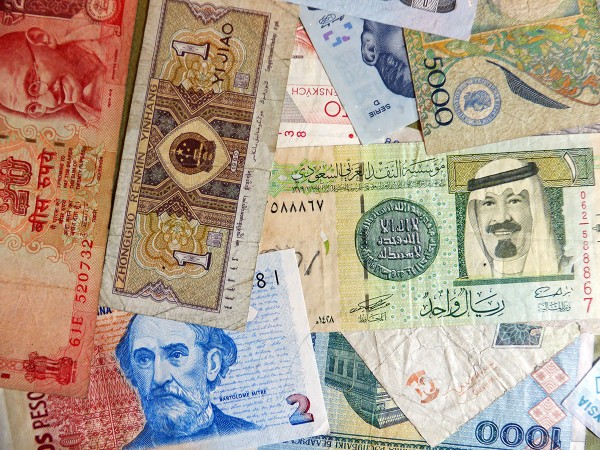 Keynes, says Elliott, would approve of the initial response to the crisis: expansionary monetary policy (both lower interest rates and then quantitative easing) backed up by expansionary fiscal policy in 2009. But expansionary fiscal policies were short lived. Instead, austerity fiscal policies were adopted in an attempt to reduce public-sector deficits and, ultimately, public-sector debt. This slowed down the recovery and meant that much of the monetary expansion went into inflating the prices of assets, such as housing and shares, rather than in financing higher investment.
Keynes, says Elliott, would approve of the initial response to the crisis: expansionary monetary policy (both lower interest rates and then quantitative easing) backed up by expansionary fiscal policy in 2009. But expansionary fiscal policies were short lived. Instead, austerity fiscal policies were adopted in an attempt to reduce public-sector deficits and, ultimately, public-sector debt. This slowed down the recovery and meant that much of the monetary expansion went into inflating the prices of assets, such as housing and shares, rather than in financing higher investment.
He also asks his imaginary Keynes what he’d recommend as the way forward today. Keynes outlines three alternatives to the current austerity policies, each involving expansionary fiscal policy:
|
|
| • |
Trump’s policies of tax cuts combined with some increase in infrastructure spending. The problems with this are that there would be too little of the public infrastructure spending that the US economy needs and that the stimulus would be poorly focused. |
| • |
Government taking advantage of exceptionally low interest rates to borrow to invest in infrastructure. “Governments could do this without alarming the markets, Keynes says, if they followed his teachings and borrowed solely to invest.” |
| • |
Use money created through quantitative easing to finance public-sector investment in infrastructure and housing. “Building homes with QE makes sense; inflating house prices with QE does not.” (See the blogs, A flawed model of monetary policy and Global warning). |
Increased government spending on infrastructure has been recommended by international organisations, such as the OECD and the IMF (see OECD goes public and The world economic outlook – as seen by the IMF). With the rise in populism and worries about low economic growth throughout much of the developed world, perhaps Keynesian fiscal policy will become more popular with governments.
Article
Keynesian economics: is it time for the theory to rise from the dead?, The Guardian, Larry Elliott (11/12/16)
Questions
- What are the main factors determining a country’s long-term rate of economic growth?
- What are the benefits and limitations of using fiscal policy to raise global economic growth?
- What are the benefits and limitations of using new money created by the central bank to fund infrastructure spending?
- Draw an AD/AS diagram to illustrate the effect of a successful programme of public-sector infrastructure projects on GDP and prices.
- Draw a Keynesian 45° line diagram to illustrate the effect of a successful programme of public-sector infrastructure projects on actual and potential GDP.
- Why might an individual country benefit more from a co-ordinated expansionary fiscal policy of all countries rather than being the only country to pursue such a policy?
- Compare the relative effectiveness of increased government investment in infrastructure and tax cuts as alterative forms of expansionary fiscal policy.
- What determines the size of the multiplier effect of such policies?
- What supply-side policies could the government adopt to back up monetary and fiscal policy? Are the there lessons here from the Japanese government’s ‘three arrows’?
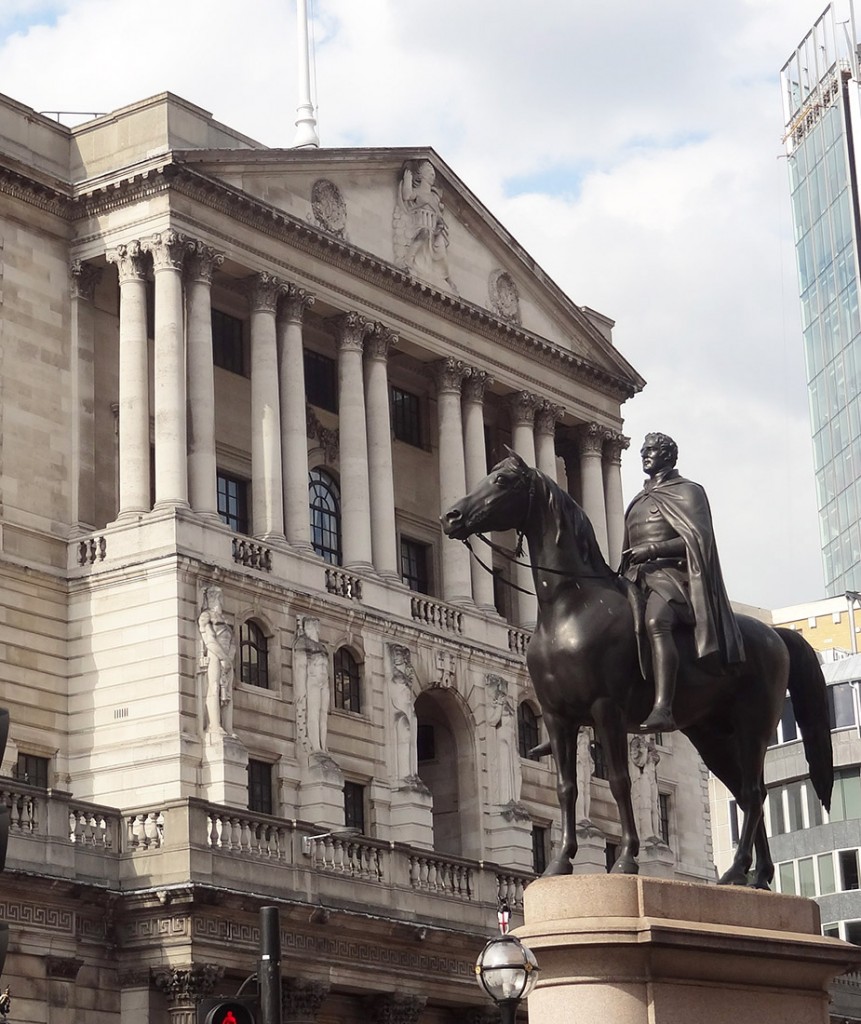 The Bank of England has responded to forecasts of a dramatic slowdown in the UK economy in the wake of the Brexit vote. On 4th August, it announced a substantial easing of monetary policy, but still left room for further easing later.
The Bank of England has responded to forecasts of a dramatic slowdown in the UK economy in the wake of the Brexit vote. On 4th August, it announced a substantial easing of monetary policy, but still left room for further easing later.
Its new measures are based on the forecasts in its latest 3-monthly Inflation Report. Compared with the May forecasts, the Report predicts that, even with the new measures, aggregate demand growth will slow dramatically. As a result, over the next two years cumulative GDP growth will be 2.5% lower than it would have been with a Remain vote and unemployment will rise from 4.9% to around 5.5%.
What is more, the slower growth in aggregate demand will impact on aggregate supply. As the Governor said in his 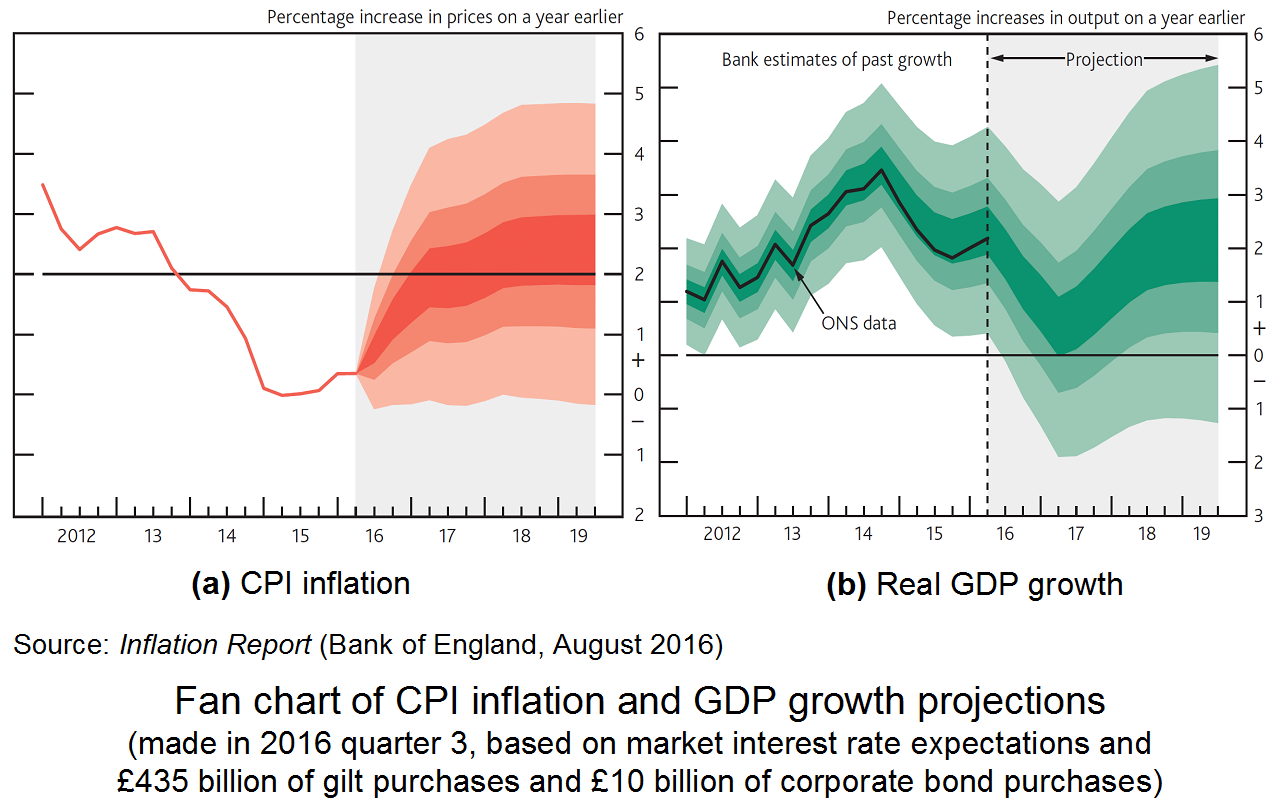 opening remarks at the Inflation Report press conference:
opening remarks at the Inflation Report press conference:
“The weakness in demand will itself weigh on supply as a period of low investment restrains growth in the capital stock and productivity.
There could also be more direct implications for supply from the decision to leave the European Union. The UK’s trading relationships are likely to change, but precisely how will be unclear for some time. If companies are uncertain about the future impact of this on their businesses, they could delay decisions about building supply capacity or entering new markets.”
Three main measures were announced.
|
|
| • |
A cut in Bank Rate from 0.5% to 0.25%. This is the first time Bank Rate has been changed since March 2009. The Bank hopes that banks will pass this on to customers in terms of lower borrowing rates. |
| • |
A new ‘Term Funding Scheme (TFS)’. “Compared to the old Funding for Lending Scheme, the TFS is a pure monetary policy instrument that is likely to be more stimulative pound-for-pound.” The scheme makes £100bn of central bank reserves available as loans to banks and building societies. These will be at ultra-low interest rates to enable banks to pass on the new lower Bank Rate to customers in all forms of lending. What is more, banks will be charged a penalty if they do not lend this money. |
| • |
An expansion of the quantitative easing programme beyond the previous £375 billion of gilt (government bond) purchases. This will consist of an extra £60bn of gilt purchases and the purchase of up to £10bn of UK corporate bonds. |
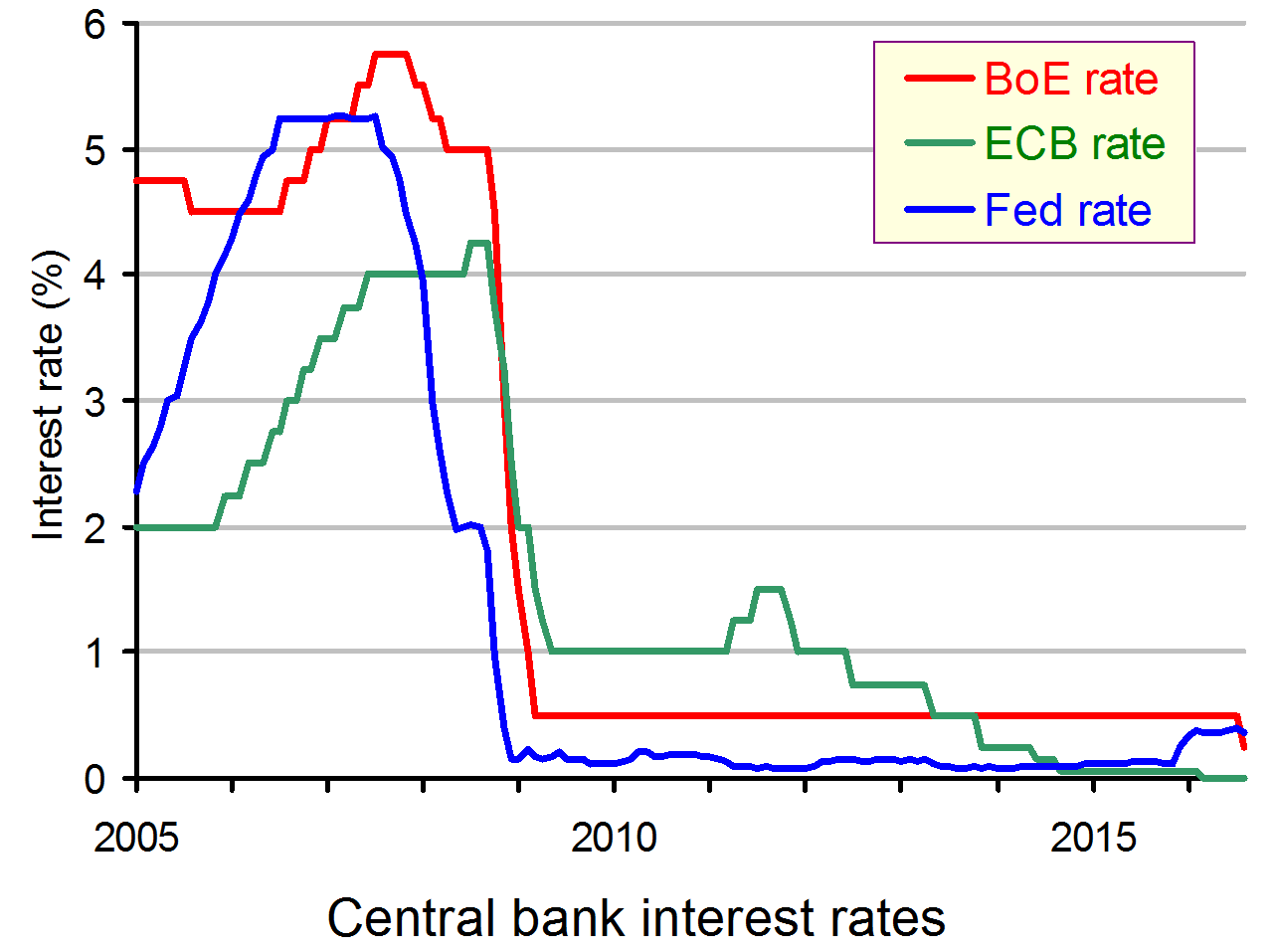 The Bank recognises that there is a limit to what monetary policy can do and that there is also a role to play for fiscal policy. The new Chancellor, Philip Hammond, is considering what fiscal measures can be taken, including spending on infrastructure projects. These are likely to have relative high multiplier effects and would also increase aggregate supply at the same time. But we will have to wait for the Autumn Statement to see what measures will be taken.
The Bank recognises that there is a limit to what monetary policy can do and that there is also a role to play for fiscal policy. The new Chancellor, Philip Hammond, is considering what fiscal measures can be taken, including spending on infrastructure projects. These are likely to have relative high multiplier effects and would also increase aggregate supply at the same time. But we will have to wait for the Autumn Statement to see what measures will be taken.
But despite the limits to monetary policy, there is more the Bank of England could do. It already recognises that there may have to be a further cut in Bank Rate, perhaps to 0.1% or even to 0% (the ECB has a 0% rate). There could also be additional quantitative easing or additional term funding to banks.
 Some economists argue that the Bank should go further still and, in conjunction with the Treasury, provide new money directly to fund infrastructure spending or tax cuts, or even as cash handouts to households. This extra money provided to the government would not increase government borrowing.
Some economists argue that the Bank should go further still and, in conjunction with the Treasury, provide new money directly to fund infrastructure spending or tax cuts, or even as cash handouts to households. This extra money provided to the government would not increase government borrowing.
We discussed the use of this version of ‘helicopter money’ in the blogs, A flawed model of monetary policy, Global warning and People’s quantitative easing. Some of the articles below also consider the potential for this type of monetary policy. In a letter to The Guardian 35 economists advocate:
A fiscal stimulus financed by central bank money creation [which] could be used to fund essential investment in infrastructure projects – boosting the incomes of businesses and households, and increasing the public sector’s productive assets in the process. Alternatively, the money could be used to fund either a tax cut or direct cash transfers to households, resulting in an immediate increase of household disposable incomes.
Webcasts and podcasts
 Inflation Report Press Conference Bank of England, Mark Carney (4/8/16)
Inflation Report Press Conference Bank of England, Mark Carney (4/8/16)
 Bank spells out chance of further rate cut this year BBC Radio 4 Today Programme, Ben Broadbent, Deputy Governor of the Bank of England (5/8/16)
Bank spells out chance of further rate cut this year BBC Radio 4 Today Programme, Ben Broadbent, Deputy Governor of the Bank of England (5/8/16)
 Broadbent Ready to Back Another BOE Rate Cut Amid Slowdown Bloomberg, Chris Wyllie (5/8/16)
Broadbent Ready to Back Another BOE Rate Cut Amid Slowdown Bloomberg, Chris Wyllie (5/8/16)
 What’s Top of Mind? ‘Helicopter Money’ Goldman Sachs Macroeconomic Insights, Allison Nathan (April 2016)
What’s Top of Mind? ‘Helicopter Money’ Goldman Sachs Macroeconomic Insights, Allison Nathan (April 2016)
Articles
Bank of England measures
Interest rate cut: What did the Bank of England announce today and how will it affect you? Independent, Ben Chu (5/8/16)
This is the Bank of England’s all-action response to Brexit The Guardian, Larry Elliott (4/8/16)
Bank of England unveils four-pronged stimulus package in bid to avoid Brexit recession The Telegraph, Szu Ping Chan (4/8/16)
Record-breaking Bank of England Financial Times, Robin Wigglesworth (4/8/16)
The Bank of England has delivered – now for a fiscal response Financial Times (4/8/16)
Bank of England Cuts Interest Rate to Historic Low, Citing Economic Pressures New York Times, Chad Bray (4/8/16)
Sledgehammer? This is more like the small tool to fix a fence The Telegraph, Andrew Sentance (5/8/16)
All eyes are on Hammond as Bank runs low on options The Telegraph, Tom Stevenson (6/8/16)
Bank of England’s stimulus package has bought the chancellor some time The Guardian, Larry Elliott (7/8/16)
Helicopter money
A post-Brexit economic policy reset for the UK is essential Guardian letters, 35 economists (3/8/16)
Cash handouts are best way to boost British growth, say economists The Guardian, Larry Elliott (4/8/16)
Helicopter money: if not now, when? Financial Times, Martin Sandbu (2/8/16)
The helicopters fly on for now, but one day they will crash The Telegraph, Tom Stevenson (23/7/16)
Is the concept of ‘helicopter money’ set for a resurgence? The Conversation, Phil Lewis (2/8/16)
Helicopter money talk takes flight as Bank of Japan runs out of runway Reuters, Stanley White (30/7/16)
Helicopters 101: your guide to monetary financing Deutsche Bank Research, George Saravelos, Daniel Brehon and Robin Winkler (15/4/16)
Helicopter money is back in the air The Guardian, Robert Skidelsky (22/9/16)
Bank of England publications
Inflation Report, August 2016 Bank of England (4/8/16)
Inflation Report Press Conference: Opening Remarks by the Governor Bank of England, Mark Carney (4/8/16)
Inflation Report Q&A Bank of England Press Conference (4/8/16)
Inflation Report, August 2016: Landing page Bank of England (4/8/16)
Questions
- Find out the details of the previous Funding for Lending (FLS) scheme. How does the new Term Funding Scheme (TFS) differ from it? Why does the Bank of England feel that TFS is likely to be more effective than FLS in expanding lending?
- What is the transmission mechanism between asset purchases and real aggregate demand?
- What factors determine the level of borrowing in the economy? How is cutting Bank Rate from 0.5% to 0.25% likely to affect borrowing?
- If the Bank of England’s latest forecast is for a significant reduction in economic growth from its previous forecast, why did the Bank not introduce stronger measures, such as larger asset purchases or a cut in Bank Rate to 0.1%?
- What are the advantages and disadvantages of helicopter money in the current circumstances? If helicopter money were used, would it be better to use it for funding public-sector infrastructure projects or for cash handouts to households, either directly or in the form of tax cuts?
- How does the Bank of England’s measures of 4 August compare with those announced by the Japanese central bank on 29 July?
- What effects can changes in aggregate demand have on aggregate supply?
- What supply-side policies could the government adopt to back up monetary and fiscal policy? Are the there lessons here from the Japanese government’s ‘three arrows’?
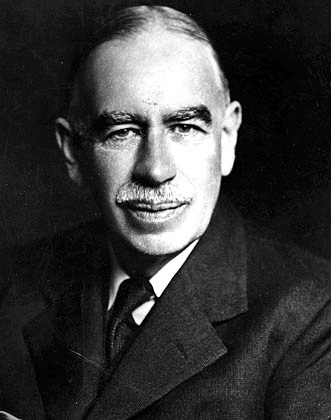 Here are two thought-provoking articles from The Guardian. They look at macroeconomic policy failures and at the likely consequences.
Here are two thought-provoking articles from The Guardian. They look at macroeconomic policy failures and at the likely consequences.
In first article, Larry Elliott, the Guardian’s Economics Editor, argues that Keynesian expansionary fiscal and monetary policy by the USA has allowed it to achieve much more rapid recovery than Europe, which, by contrast, has chosen to follow fiscal austerity policies and only recently mildly expansionary monetary policy through a belated QE programme.
In the UK, the recovery has been more significant than in the eurozone because of the expansionary monetary policies pursued by the Bank of England in its quantitative easing programme. ‘And when it came to fiscal policy, George Osborne quietly abandoned his original deficit reduction targets when the deleterious impact of an over-aggressive austerity strategy became apparent.’
So, according to Larry Elliott, Europe should ease up on austerity and governments should invest more though increased borrowing.
‘This is textbook Keynesian stuff. Unemployment is high, which means businesses are reluctant to invest. The lack of investment means that demand for new loans is weak. The weakness of demand for loans means that driving down the cost of borrowing through QE will have little impact. Therefore, it is up to the state to break into the vicious circle by investing itself, something it can do cheaply and – because there are so many people unemployed and businesses working well below full capacity – without the risk of inflation.’
In the second article, Paul Mason, the Economics Editor at Channel 4 News, points to the large increases in both public- and private- sector  debt since 2007, despite the recession. Such debt, he argues, is becoming unsustainable and hence the world could be on the cusp of another crash.
debt since 2007, despite the recession. Such debt, he argues, is becoming unsustainable and hence the world could be on the cusp of another crash.
Mason quotes from the Bank for International Settlements Quarterly Review September 2015 – media briefing. In this briefing, Claudio Borio,
Head of the Monetary & Economic Department, argues that:
‘Since at least 2009, domestic vulnerabilities have developed in several emerging market economies (EMEs), including some of the largest, and to a lesser extent even in some advanced economies, notably commodity exporters. In particular, these countries have exhibited signs of a build-up of financial imbalances, in the form of outsize credit booms alongside strong increases in asset prices, especially property prices, supported by unusually easy global liquidity conditions. It is the coincidence of the reversal of these booms with external vulnerabilities that should be watched most closely.’
 We have already seen a fall in commodity prices, reflecting the underlying lack of demand, and large fluctuations in stock markets. The Chinese economy is slowing markedly, as are several other EMEs, and Europe and Japan are struggling to recover, despite their QE programmes. The USA is no longer engaging in QE and there are growing worries about a US slowdown as growth in the rest of the world slows. Mason, quoting the BIS briefing, states that:
We have already seen a fall in commodity prices, reflecting the underlying lack of demand, and large fluctuations in stock markets. The Chinese economy is slowing markedly, as are several other EMEs, and Europe and Japan are struggling to recover, despite their QE programmes. The USA is no longer engaging in QE and there are growing worries about a US slowdown as growth in the rest of the world slows. Mason, quoting the BIS briefing, states that:
‘In short, as the BIS economists put it, this is “a world in which debt levels are too high, productivity growth too weak and financial risks too threatening”. It’s impossible to extrapolate from all this the date the crash will happen, or the form it will take. All we know is there is a mismatch between rising credit, falling growth, trade and prices, and a febrile financial market, which, at present, keeps switchback riding as money flows from one sector, or geographic region, to another.’
So should there be more expansionary policy, or should rising debt levels be reduced by tighter monetary policy? Read the articles and then consider the questions.
I told you so. Obama right and Europe wrong about way out of Great Recession The Guardian, Larry Elliott (1/11/15)
Apocalypse now: has the next giant financial crash already begun? The Guardian, Paul Mason (1/11/15)
Questions
- To what extent do the two articles (a) agree and (b) disagree?
- How might a neo-liberal economist reply to the argument that what is needed is more expansionary fiscal and monetary policies?
- What is the transmission mechanism whereby quantitative easing affects real output? Is it a reliable mechanism for policymakers?
- What would make a financial crash less likely? Is this something that governments or central banks can influence?
- Why has productivity growth been so low in many countries? What would increase it?
 After promises made back in July 2012 that the ECB will ‘do whatever it takes’ to protect the eurozone economy, the ECB has at last done just that. It has launched a large-scale quantitative easing programme. It will create new money to buy €60 billion of assets every month in the secondary market.
After promises made back in July 2012 that the ECB will ‘do whatever it takes’ to protect the eurozone economy, the ECB has at last done just that. It has launched a large-scale quantitative easing programme. It will create new money to buy €60 billion of assets every month in the secondary market.
Around €10 billion will be private-sector securities that are currently being purchased under the asset-backed securities purchase programme (ABSPP) and the covered bond purchase programme (CBPP3), which were both launched late last year. The remaining €50 billion will be public-sector assets, mainly bonds of governments in the eurozone. This extended programme of asset purchases will begin in March this year and continue until at least September 2016, bringing the total of asset purchased by that time to over €1.1 trillion.
The ECB has taken several steps towards full QE over the past few months, including €400 billion of targeted long-term lending to banks, cutting interest rates to virtually zero (and below zero for the deposit rate) and the outright purchase of private-sector assets. But all these previous moves failed to convince markets that they would be enough to stimulate recovery and stave off deflation. Hence the calls for full quantitative easing became louder and it was widely anticipated that the ECB would finally embark on the purchase of government bonds – in other words, would finally adopt a programme of QE similar to those adopted in the USA (from 2008), the UK (from 2009) and Japan (from 2010).
Rather than the ECB buying the government bonds centrally, each of the 19 national central banks (NCBs), which together with the ECB constitute the Eurosystem, will buy their own nation’s bonds.  The amount they will buy will depend on their capital subscriptions the eurozone. For example, the German central bank will buy German bonds amounting to 25.6% of the total bonds purchased by national central banks. France’s share will be 20.1% (i.e. French bonds constituting 20.1% of the total), Spain’s share will be 12.6% and Malta’s just 0.09%.
The amount they will buy will depend on their capital subscriptions the eurozone. For example, the German central bank will buy German bonds amounting to 25.6% of the total bonds purchased by national central banks. France’s share will be 20.1% (i.e. French bonds constituting 20.1% of the total), Spain’s share will be 12.6% and Malta’s just 0.09%.
Central banks of countries that are still in bail-out programmes will not be eligible to purchase their countries’ assets while their compliance with the terms of the bailout is under review (as is the case currently with Greece).
The risk of government default on their bonds will be largely (80%) covered by the individual countries’ central banks, not by the central banks collectively. Only 20% of bond purchases will be subject to risk sharing between member states according to their capital subscription percentages: the ECB will directly purchase 8% of government bonds and 12% will be bonds issued by European institutions rather than countries. As the ECB explains it:
With regard to the sharing of hypothetical losses, the Governing Council decided that purchases of securities of European institutions (which will be 12% of the additional asset purchases, and which will be purchased by NCBs) will be subject to loss sharing. The rest of the NCBs’ additional asset purchases will not be subject to loss sharing. The ECB will hold 8% of the additional asset purchases. This implies that 20% of the additional asset purchases will be subject to a regime of risk sharing.
As with the QE programmes in the USA, the UK and Japan, the transmission mechanism is indirect. The assets purchased will be from financial institutions, who will thus receive the new money. The bond purchases and the purchases of assets by financial institutions with the acquired new money will drive up asset prices and hence drive down long-term interest rates. This, hopefully, will stimulate borrowing and increase aggregate demand and hence output, employment and prices.
The ECB will buy bonds issued by euro area central governments, agencies and European institutions in the secondary market against central bank money, which the institutions that sold the securities can use to buy other assets and extend credit to the real economy. In both cases, this contributes to an easing of financial conditions.
In addition, there is an exchange rate transmission mechanism. To the extent that the extra money is used to purchase non-eurozone assets, so this will drive down the euro exchange rate. This, in turn, will boost the demand for eurozone exports and reduce the demand for imports to the eurozone. This, again, represents an increase in aggregate demand.
The extent to which people will borrow more depends, of course, on confidence that the eurozone economy will expand. So far, the response of markets suggests that such confidence will be there. But we shall have to wait to see if the confidence is sustained.
But even if QE does succeed in stimulating aggregate demand, there remains the question of the competitiveness of eurozone economies. Some people are worried, especially in Germany, that the boost given by QE will reduce the pressure on countries to engage in structural reforms – reforms that some people feel are vital for long-term growth in the eurozone
The articles consider the responses to QE and assess its likely impact.
Articles
ECB publications
Previous blog posts
Data
Questions
- Why has the ECB been reluctant to engage in full QE before now?
- How has the ECB answered the objections of strong eurozone countries, such as Germany, to taking on the risks associated with weaker countries?
- What determines the amount by which aggregate demand will rise following a programme of asset purchases?
- In what ways and to what extent will non-eurozone countries benefit or lose from the ECB’s decision?
- Are there any long-term dangers to the eurozone economy of the ECB’s QE programme? If so, how might they be tackled?
- Why did the euro plummet on the ECB’s announcement? Why had it not plummeted before the announcement, given that the introduction of full QE was widely expected?
 With the imposition of a new lockdown in England from 5 November to 2 December and in Wales from 3 October to 9 November, and with strong restrictions in Scotland and Northern Ireland, the UK economy is set to return to negative growth – a W-shaped GDP growth curve.
With the imposition of a new lockdown in England from 5 November to 2 December and in Wales from 3 October to 9 November, and with strong restrictions in Scotland and Northern Ireland, the UK economy is set to return to negative growth – a W-shaped GDP growth curve.  The fall in aggregate supply is represented partly by a movement along the short-run aggregate supply curve (SRAS) as demand falls for businesses which remain open (such as transport services). Largely it is represented by a leftward shift in the curve from SRAS1 to SRAS2 as businesses such as non-essential shops and those in the hospitality and leisure sector are forced to close. What happens to the long-run supply curve depends on the extent to which businesses reopen when the lockdown and any other subsequent restrictions preventing their reopening are over. It also depends on the extent to which other firms spring up or existing firms grow to replace the business of those that have closed. The continuing rise in online retailing is an example.
The fall in aggregate supply is represented partly by a movement along the short-run aggregate supply curve (SRAS) as demand falls for businesses which remain open (such as transport services). Largely it is represented by a leftward shift in the curve from SRAS1 to SRAS2 as businesses such as non-essential shops and those in the hospitality and leisure sector are forced to close. What happens to the long-run supply curve depends on the extent to which businesses reopen when the lockdown and any other subsequent restrictions preventing their reopening are over. It also depends on the extent to which other firms spring up or existing firms grow to replace the business of those that have closed. The continuing rise in online retailing is an example. In March, the Chancellor introduced the furlough scheme, whereby employees temporarily laid off would receive 80% of their wages through a government grant to their employers. This scheme was due to end on 31 October, to be replaced by the less generous Job Support Scheme (see the blog, The new UK Job Support Scheme: how much will it slow the rise in unemployment?). However, the Chancellor first announced that the original furlough scheme would be extended until 2 December for England and then, on 5 November, to the end of March 2021 for the whole of the UK. He also announced that the self-employed income support grant would increase from 55% to 80% of average profits up to £7500.
In March, the Chancellor introduced the furlough scheme, whereby employees temporarily laid off would receive 80% of their wages through a government grant to their employers. This scheme was due to end on 31 October, to be replaced by the less generous Job Support Scheme (see the blog, The new UK Job Support Scheme: how much will it slow the rise in unemployment?). However, the Chancellor first announced that the original furlough scheme would be extended until 2 December for England and then, on 5 November, to the end of March 2021 for the whole of the UK. He also announced that the self-employed income support grant would increase from 55% to 80% of average profits up to £7500. An additional £150 billion of government bonds will be purchased under the asset purchase facility (APF). This will bring the total vale of bonds purchased since the start of the pandemic to £450 billion (including £20 billion of corporate bonds) and to £895 billion since 2009 when QE was first introduced in response to the recession following the financial crisis of 2007–8.
An additional £150 billion of government bonds will be purchased under the asset purchase facility (APF). This will bring the total vale of bonds purchased since the start of the pandemic to £450 billion (including £20 billion of corporate bonds) and to £895 billion since 2009 when QE was first introduced in response to the recession following the financial crisis of 2007–8. 
 Coronavirus: Bank of England unleashes further £150bn of support for economy
Coronavirus: Bank of England unleashes further £150bn of support for economy








